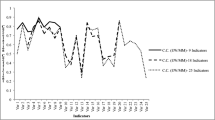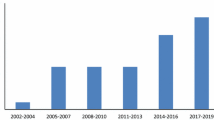Abstract
Despite their increasing use, composite indicators remain controversial. The undesirable dependence of countries’ rankings on the preliminary normalization stage, and the disagreement among experts/stakeholders on the specific weighting scheme used to aggregate sub-indicators, are often invoked to undermine the credibility of composite indicators. Data envelopment analysis may be instrumental in overcoming these limitations. One part of its appeal in the composite indicator context stems from its invariance to measurement units, which entails that a normalization stage can be skipped. Secondly, it fills the informational gap in the ‘right’ set of weights by generating flexible ‘benefit of the doubt’-weights for each evaluated country. The ease of interpretation is a third advantage of the specific model that is the main focus of this paper. In sum, the method may help to neutralize some recurring sources of criticism on composite indicators, allowing one to shift the focus to other, and perhaps more essential stages of their construction.
Similar content being viewed by others
References
Babbie E. (1995) The Practice of Social Research. Wadsworth Publishing Company, Belmont
Booysen F. (2002) An Overview and Evaluation of Composite Indices of Development. Social Indicators Research 59: 115–151
Brandolini A. (2002) Education and Employment Indicators for the EU Social Agenda. Politica Economica 18: 55–62
Charnes A., Cooper W. W., Rhodes E. (1978) Measuring the Efficiency of Decision Making Units. European Journal of Operational Research 2: 429–444
Cherchye L., C. A. K. Lovell, W. Moesen and T. Van Puyenbroeck: 2005, ‘One Market, One Number? A Composite Indicator Assessment of EU Internal Market Dynamics’, forthcoming in European Economic Review
Cherchye L., Moesen W., Van Puyenbroeck T. (2004) Legitimately Diverse, Yet Comparable: On Synthesizing Social Inclusion Performance in the EU. Journal of Common Market Studies 42:919–955
Cherchye, L. and T. Kuosmanen: 2006, ‘Benchmarking Sustainable Development: A Synthetic Meta-Index Approach’ Chapter 7. in M. McGillivray and M. Clarke (eds), Perspectives on Human Development (United Nations University Press), to appear
Cook, W. D.: 2004, ‘Qualitative Data in DEA’, in W. W. Cooper, L. Seiford and J. Zhu (eds), Handbook on Data Envelopment Analysis (Kluwer Academic Publishers, Dordrecht), pp.␣75–97
Cook W. D., Kress M. (1991) A Multiple Criteria Decision Model with Ordinal Preference Data. European Journal of Operations Research 54: 191–193
Cook W. D., Kress M. (1994) A Multiple Criteria Composite Index Model for Quantitative and Qualitative Data. European Journal of Operations Research 78: 367–379
Cooper, W. W., L. M. Seiford and K. Tone: 2000, Data Envelopment Analysis: A Comprehensive Text with Models, Applications, References and DEA-Solver Software (Kluwer Academic Publishers, Dordrecht)
Cooper, W. W., L. M. Seiford and J. Zhu: 2004, Handbook on Data Envelopment Analysis (Kluwer Academic Publishers, Dordrecht)
Desai, M., S. Fukuda-Parr, C. Johansson and F. Sagasti: 2002, ‘Measuring the Technology Achievement of Nations and the Capacity to Participate in the Networking Age’. Journal of Human Development 3(1), pp. 95–122
Despotis, D. K.: 2005, ‘A Reassessment of the Human Development Index via Data Envelopment Analysis’, Journal of the Operational Research Society 56(8), pp. 969–980
Ebert U., Welsch H. (2004) Meaningful Environmental Indices: A Social Choice Approach. Journal of Environmental Economics and Management 47: 270–283
European Commission: 2004, The EU Economy Review 2004, European Economy, Nr. 6 (Office for Official Publications of the EC, Luxembourg)
Foster, J. and A. Sen: 1997, On Economic Inequality, 2nd expanded edn (Clarendon Press, Oxford)
Freudenberg, M.: 2003, ‘Composite Indicators of Country Performance: A Critical Assessment’, OECD Science, Technology and Industry Working Papers 2003/16
Golany, B.: 1988, ‘A Note on Including Ordinal Relations among Multipliers in Data Envelopment Analysis’, Management Science 34(8), pp. 1029–1033
Halme M., Joro T., Koivu M. (2002) Dealing with Interval Scale Data in Data Envelopment Analysis. European Journal of Operational Research 137: 22–27
Hopkins M. (1991) Human Development Revisited: A New UNDP Report. World Development 19: 1469–1473
Kao C., Hung H. T. (2005) Data Envelopment Analysis with Common Weights: The Compromise Solution Approach. Journal of the Operational Research Society 56: 1196–1203
Kumar S., Russel R. R. (2002) Technical Change, Technological Catch-Up, and Capital Deepening: Relative Contributions to Growth and Convergence. American Economic Review 92: 527–548
Lovell C. A. K, Pastor J. T., Turner J. A. (1995) Measuring Macroeconomic Performance in the OECD: A Comparison of European and Non-European Countries. European Journal of Operational Research 87: 507–518
Mahlberg, B. and M. Obersteiner: 2001, ‘Remeasuring the HDI by Data Envelopment Analysis’, International Institute for Applied Systems Analysis Interim Report 01–069
Melyn, W. and W. Moesen: 1991, ‘Towards a Synthetic Indicator of Macroeconomic Performance: Unequal Weighting when Limited Information is Available’, Public Economics Research Paper 17, CES, KU Leuven
Micklewright, J.: 2001, ‘Should the UK Government Measure Poverty and Social Exclusion with a Composite Index?’, in CASE, Indicators of progress: A Discussion of Approaches to Monitor the Government’s Strategy to Tackle Poverty and Social Exclusion, CASE Report 13, London School of Economics
Munda, G. and M. Nardo: 2003, ‘On the Methodological Foundations of Composite Indicators Used for Ranking Countries’, mimeo, Universitat Autonoma de Barcelona
Nardo, M., M. Saisana, A. Saltelli and S. Tarantola (EC/JRC) and A. Hoffman and E. Giovannini (OECD): 2005, Handbook on Constructing Composite Indicators: Methodology and User Guide, OECD Statistics Working Paper
Pedraja-Chap arro F., Salinas-Jimenez J., Smith P. (1997) On the Role of Weight Restrictions in Data Envelopment Analysis. Journal of Productivity Analysis 8: 215–230
Saisana M., Saltelli A., Tarantola S. (2005) Uncertainty and Sensitivity Analysis as tools for the quality assessment of composite indicators. Journal of the Royal Statistical Society Series A 168: 1–17
Semple J. (1996) Constrained Games for Evaluating Organizational Performance. European Journal of Operational Research 96: 103–112
Storrie, D. and H. Bjurek: 2000, ‘Benchmarking European Labour Market Performance with Efficiency Frontier Techniques’, CELMS Discussion Paper, Göteborg University
Thanassoulis, E., M. C. Portela and R. Allen: 2004, ‘Incorporating Value Judgements in DEA’, in W. W. Cooper, L. Seiford and J. Zhu (eds), Handbook on Data Envelopment Analysis (Kluwer Academic Publishers, Dordrecht), pp. 99–138
Wong Y. H. B., Beasly J. E. (1990) Restricting Weight Flexibility in Data Envelopment Analysis. Journal of the Operational Research Society 41: 829–835
Zaim O., Färe R., Grosskopf S. (2001) An Economic Approach to Achievement and Improvement Indexes. Social Indicators Research 56: 91–118
Zhu, J.: 2003, Quantitative Models for Performance Evaluation and Benchmarking, International Series in Operations Research and Management Science (Kluwer Academic Publishers, Dordrecht)
Author information
Authors and Affiliations
Corresponding author
Additional information
An abridged version of this paper was presented at the Workshop on European Indicators and Scoreboards, organised by DG Education and the Joint Research Centre within the auspices of CRELL, in Brussels, October 24–25, 2005.
Appendices
Appendix 1: The Technology Achievement Index and Expert Opinion on Weights
The United Nations’ TAI index is developed to capture country performances in creating, adapting and using global technological innovations. Desai et al. (2002) define it as a composite indicator of technological progress that ranks countries on a comparative global scale. The TAI focuses on achievements in four dimensions: creating new technology, diffusing recent innovations, diffusing existing technologies which are still basic inputs to the industrial and the network age and building a human skill base for technology creation and adaptation. Eight sub-indicators capture these dimensions (with two sub-indicators for each dimension): the number of patents granted per 1,000,000 people, the receipt of royalties in US $ per 1000 inhabitants; the number of internet hosts per 1000 people, the exports of high and medium technology products as a share of total goods exports; the number of telephone lines per 1000 people (expressed in logarithms), electricity consumption per capita in kWh (also in logs); the mean years of schooling, and the gross enrolment ratio of tertiary students in science, mathematics and engineering. The eight selected sub-indicators all are ‘goods’ so that higher values reflect better performance. For extensive explanations on the sub-indicators we refer to Desai et al. (2002). The list immediately shows the different units of measurement across sub-indicators, a recurring issue in the construction of composite indicators. In the calculations of the actual TAI, data are first normalized to overcome this problem. We deviate from this common practice in the main text by aggregating the original data. In the original TAI the UN uses equal weights to aggregate the sub-indicators.
Nardo et al. collected opinion from 21 experts about TAI weighting schemes. The weights defined in Table A1 were obtained by using the so-called Budget allocation method.15 This is a participatory method in which experts have to distribute a budget of 100 points over the sub-indicators allocating more to what they regard to be the more important sub-indicators. It is this information we use to illustrate some possible pie share bounds.
Appendix 2: Summary Tables for (Benefit of the Doubt) Composite Indicator Values
The following table(s) A2 recapture the original TAI-values for 23 countries, and adds to this the index values as provided by the ‘full flexibility’ benefit of the doubt model (4)–(5a)–(5b); a model with ordinal sub-indicator share restrictions (8) added; one with relative sub-indicator share restrictions (9).
The second part of the table adds the proportional pie share restrictions (11), and its counterpart (12), putting bounds on the four categories. One interesting idea, that we have not pursued in this paper, is checking the robustness of the country rankings (or scores) to this different scenario’s by uncertainty/sensitivity analysis (see e.g. Nardo et al. (2005), or Saisana et al. (2005)).
Rights and permissions
About this article
Cite this article
Cherchye, L., Moesen, W., Rogge, N. et al. An Introduction to ‘Benefit of the Doubt’ Composite Indicators. Soc Indic Res 82, 111–145 (2007). https://doi.org/10.1007/s11205-006-9029-7
Accepted:
Published:
Issue Date:
DOI: https://doi.org/10.1007/s11205-006-9029-7




